 tourist hotel of Cuba. It has been maintained in first-class shape and, we came to learn, until only a year or so ago, no Cuban national who was not employed there could enter the building unless on “official" business.
tourist hotel of Cuba. It has been maintained in first-class shape and, we came to learn, until only a year or so ago, no Cuban national who was not employed there could enter the building unless on “official" business.CUBA
January 3 - 11, 2012
* Havana *
We arrived at the Hotel Nacional de Cuba, a magnificent 1930’s edifice and the official tourist hotel of Cuba. It has been maintained in first-class shape and, we came to learn, until only a year or so ago, no Cuban national who was not employed there could enter the building unless on “official" business.
tourist hotel of Cuba. It has been maintained in first-class shape and, we came to learn, until only a year or so ago, no Cuban national who was not employed there could enter the building unless on “official" business.
We were given a brief, historical tour of the hotel while our bags were delivered to our room. Our room, #461, had a small picture posted on the wall informing residents that Robert Redford had stayed here when in Havana.


After dinner on the terrace Bill and Sandy joined us in a stroll through some of the surrounding area. We saw many young people walking the streets and standing in groups. We found an ice cream stand recommended to us by Hector and enjoyed their wares in celebration of Bill’s birthday; then back to the hotel just after 10 pm.

 After breakafast we attended a lecture by an architect from the Office of the City Architect, the official department in charge of rehabilitating Old Havana and, we learned, in charge of all tourism in the country. She spoke English beautifully and offered us an interesting PowerPoint presentation. Her husband, who had come into the room, also answered questions- he worked for UNESCO and the City of Havana as a city planner.
After breakafast we attended a lecture by an architect from the Office of the City Architect, the official department in charge of rehabilitating Old Havana and, we learned, in charge of all tourism in the country. She spoke English beautifully and offered us an interesting PowerPoint presentation. Her husband, who had come into the room, also answered questions- he worked for UNESCO and the City of Havana as a city planner.
Then back into the coach for a ride through the tunnel under the harbor entrance to El Morro, a fort built in the 16th century and located at the entrance to Havana harbor.





We enjoyed a wonderful view of Havana across the harbor and ate lunch at a waterfront restaurant with too much food served to us: mojito (ubiquitous Cuban drink), bread, shrimp, fried fish, beef and then a brownie topped with ice cream for dessert!

The coach dropped us at the harbor edge of Old Havana. We then spent 2 ½  hours walking through the four major squares that make up Old Havana (1519), looking at the restorations under construction and listening to Hector and watching the people. We passed through The Cathedral of Havana Square (1748), “Arms” Square, and the “Tree of Silk” Square.
hours walking through the four major squares that make up Old Havana (1519), looking at the restorations under construction and listening to Hector and watching the people. We passed through The Cathedral of Havana Square (1748), “Arms” Square, and the “Tree of Silk” Square.
We watched some street performers, passed by Simon Bolivar’s house and looked into several unusual but quite beautiful hotel lobbies and bars.




Lots of "old world" architecture to enjoy and a stop at Hemmingway’s favorite bar (Bodega del Medio) – with a wonderful woman sitting outside smoking a cigar and making passes at all the male passers-by.





We found ourselves in the plaza of the Church of St. Francis and, to our surprise, the was a statue to Father Junipero Serra, the friar who founded the California Missions i the 1700's - and with him was a representation of a Chumash indian, the tribe that inhabited the Ojai Valley and the Pacific coast at the time.
was a statue to Father Junipero Serra, the friar who founded the California Missions i the 1700's - and with him was a representation of a Chumash indian, the tribe that inhabited the Ojai Valley and the Pacific coast at the time.
We looked into an archaeological dig which showed the underground aqueducts of the city which were built in the 1500’s.


CLICK HERE TO SEE A MAP OF THE AQUADUCT SYSTEM

Then back to the hotel where we relaxed for awhile at an outdoor table overlooking ocean.
For dinner the coach took us to the “Embassy Quarter” of Havana where we enjoyed a pleasant, outdoor restaurant.
We were up and out by 8:30 the next morning to visit a Sephardic Jewish Temple in Havana. We learned that, after the revolution, about 90% of Cuba’s Jews left; it is estimated that there are roughly 1,200 Jews left in Cuba today. This temple had a work-out gym and a meeting room as part of the building. We dropped some of our donations with this group since the synagogue also runs a pharmacy.



For lunch we returned to Old Havana and found our way to a restaurant that was once a printing house. We enjoyed a delightful lunch watching Cubans lined up outside the windows waiting for churros from a street vendor.



Then the coach took us out to the Guanabacoa area near Havana. This area has many religious influences and we toured a museum dedicated to the practice of Santeria, the Cuban-African religion; it is a mixture of Catholic Saints and the animalistic religious practices brought to Cuba by slaves.





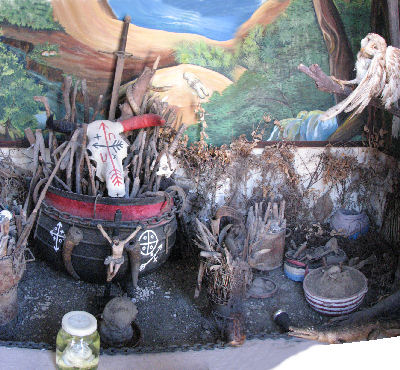



The guide explained the symbolism of the religious artifacts and we were treated to a performance of dance and music, where many of the group were encouraged by the dancers to join in.
 ( Click the picture to see some of the dancing - about 2 1/2 min. )
( Click the picture to see some of the dancing - about 2 1/2 min. )

After leaving the museum we travelled to The Church of the Black Madonna on the outskirts of Havana. Both Catholics and Santeria practitioners worship there.



Linda spent a while talking with the church carpenter discussing the exploitation of Mexican farm workers while the rest of us roamed the building. There were Santeria practitioners outside the church who would tell your fortune for a few pesos.

We returned to the coach and drove to downtown Havana for lunch at a restaurant alongside the harbor



after which we wandered on our own, with Sandy and Bill. Cubans are a remarkably warm and friendly people (and Linda’s Spanish gave us instant access to everyone and created a warm welcome). We walked and wandered for about 4 hours, meandering our way back to the hotel along the back streets.





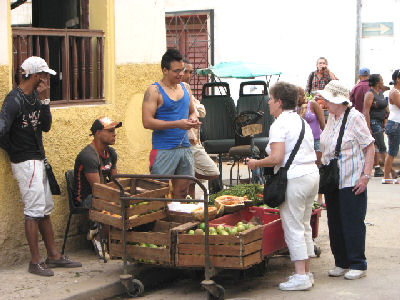







We found a small elementray school tucked into the ground floor of a building and visited with a couple of the teachers;
and then we continued wandering looking into shops, hotel lobbies and whatever caught our fancy.


We watched a school group exercising in a public park
We continued towards our hotel on the oceanside walkway which is fronted, looking out into the ocean, by the vestiges of what were, once, beautiful buildings- now mostly in a state of decay.

Back at the hotel Sandy, Bill and we enjoyed dinner in the hotel’s dining room and then to bed.


After breakfast at the hotel- its usual gigantic buffet-
we visited the Plaza de la Revolution. It’s a large square bordered by large governmental buildings on three sides with outline portraits of Fidel Castro and Che Guevara on the façade. The fourth side is a large monument to José Marti that dominated the square. He is considered to be the father of the Cuban revolution. This is the area where large rallies take place and the President addresses the gathered crowd.



And there were plenty of taxis available for hire...



 and
and
One of the pleasures of seeing Cuba was the neumber of 1950 - 1970 automobiles still on the road. Many appear to be in excellent shape and are used as taxis but many are privately owned. Although the outside looks American most of the parts are, by this time, Russian or Chinese.







Outside of the city and, occasionally, in the near suburbs, the horse and cart act as a primary method of transportation. Often our coach had to slow to a crawl when caught behind one on the narrow country roads.


The coach took us outside of the city to San Lazaro Church. Thousands of Cubans make a pilgrimage to the church each year. We watched a woman climb the outside stairs and enter the church on her knees. There were gaping holes in the walls and ceilings and some areas of the church showed relatively new paint while other places the paint was peeling off.






We left the remaining donations that we had brought with a church deacon. We had hoped to talk with some of the nuns who administer to lepers housed in a colony next to the church but they were too busy at that time.
Then into the coach and a ride to the house of Ernest Hemmingway- Finca La Vigia. He lived here for thirty years and we could look into the house from the outside- it has been kept in perfect condition with Hemmingway’s personal belongings intact.

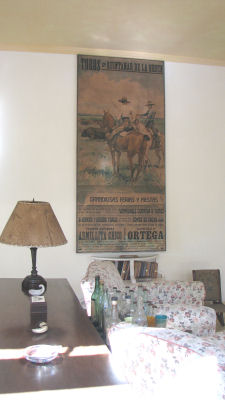




The original cost of the house and property was $18,000,000 80 years ago! We visited his writing studio with its view of Havana in the distance.



and his boat- the Pilar, which he used to patrol the Caribbean around Cuba looking for Nazis during WWII.
Then to the small fishing village of Cojimar where there is a Hemmingway memorial put up by the citizens of the village. Hemmingway dedicated his Nobel Prize to this community and helped them in many ways.

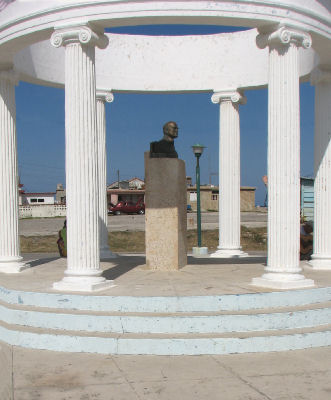

We lunched at a restaurant by El Morrow looking out into the harbor entrance and listening to an excellent “conjunto”
sing for us.




( If you would lke to hear some of their music click on the picture )
After lunch we travelled back through the tunnel to the Havana Art Museum where a curator gave us a lecture-tour on the history of Cuban art. We stopped at the Feria do Artesania San Jose, a very large building on the waterfront that contains Havana’s biggest flea market where we made some purchases of musical instruments (maracas, claves, bongos) for the grandkids.

Then back to the hotel for a lecture in the economy of Cuba by Dr. Iponte. Jon missed it because whatever group was in the room prior to ours was smoking and the cigarette smoke was everywhere so he relaxed outside in the gardens while the group met with the lecturer.
because whatever group was in the room prior to ours was smoking and the cigarette smoke was everywhere so he relaxed outside in the gardens while the group met with the lecturer.
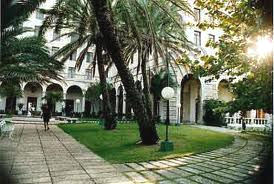
Dinner was at a very elegant restaurant- El restaurant del Oriente- on the Plaza do San Francisco. It was the best meal we ate in Havana, and the last dinner since we were leaving for Miami the next morning.
 We had been hearing rumors that the President of Iran, Ahmadinejad, was going to be at the hotel and the next morning we saw Iranian flags in the lobby.
We had been hearing rumors that the President of Iran, Ahmadinejad, was going to be at the hotel and the next morning we saw Iranian flags in the lobby.
Our bags had to be packed and ready by 11:45 am so we made them ready and, after the usual buffet breakfast, we boarded the coach for one last trip into Old Havana. We arrived before the booksellers had set up their stalls and the professional “tourist ladies” (dressed in traditional costumes) were soliciting tourists to take a picture with them- for ten pesos, of course – each one had a license from the government, it was her ‘job.’ We wandered several streets with Sandy and Bill, looked into a Museum of Arabic Art complete with peacocks wandering about, and visited a museum of old cars (1920-1930’s), almost all of them in various states of disrepair- only one had been rebuilt… again a matter of available money.
 Back to the hotel for a last check in the hotel room. Looking out the window and there was a long line of black limousines where the taxis normally stood. We went into the
Back to the hotel for a last check in the hotel room. Looking out the window and there was a long line of black limousines where the taxis normally stood. We went into the  hotel’s small bistro for a quick lunch and when we came back up to the lobby we were stopped at the head of the stairs. All of the hotel staff were lined up.
hotel’s small bistro for a quick lunch and when we came back up to the lobby we were stopped at the head of the stairs. All of the hotel staff were lined up.
As we watched a small man surrounded by ‘men in suits’ came down the hallway waving at everyone- Ahmadinejad. He passed within five feet of us.
We then attempted to get to our group and the bus but Hector informed us that the bus was delayed because security had sealed off the roads around the hotel- and we had a scheduled time to be at the airport for check-in. So we waited and watched one of the Cuban Vice-Presidents arrive.

Finally the coach was able to get in.
We watched to make sure our luggage was placed into the hold of the vehicle ad then got aboard for the trip to the airport- 30 minutes late. We found lines at the counter and we were the last of our group to check in- the agent had to find a supervisor because we were so late there were no non-assigned seats left, but he accommodated us. Saying goodbye to Hector and Jim (who had another Roads Scholar group arriving that afternoon) we passed through customs.



We travelled on an old Boeing 747 and flew through some very turbulent air on our way to Miami. It was the edge of a weather front heading over Cuba- while we enjoyed wonderful weather for our trip, the forecast in Havana was for rain. The flight quieted as we reached Miami. We obtained our bags, went through passport control and customs with no problems.


Sandy and Bill were heading to north Florida to visit with Sandy’s cousins and we were going to drive to West Palm Beach to spend a couple of days with Jon’s cousins. When we got to the Alamo Car rental counter they had our reservation, but Jon could not find his wallet with the driver’s license and credit cards. We searched the luggage and our pockets- no wallet. So Linda’s license and cards were utilized and we took off for West Palm. There was a message on our cell phone- from Matt Neuberg who was visiting his brother in Ft. Lauderdale. We had hoped to be able to connect over the weekend but, unfortunately, it didn’t happen. After dinner with Joanna and John Abreau another search was made and the wallet was found in a secret, hidden compartment in his waist pack. Whew.


We spent a nice couple of days with John and Jo and then home to California, arriving in late afternoon. Up to coastal route towards Ojai and ate dinner in a Japanese restaurant in Malibu. We arrived home by 8:30 PM. and were asleep by 9 o’clock after this wonderful and picturesque visit with the Cuban people.